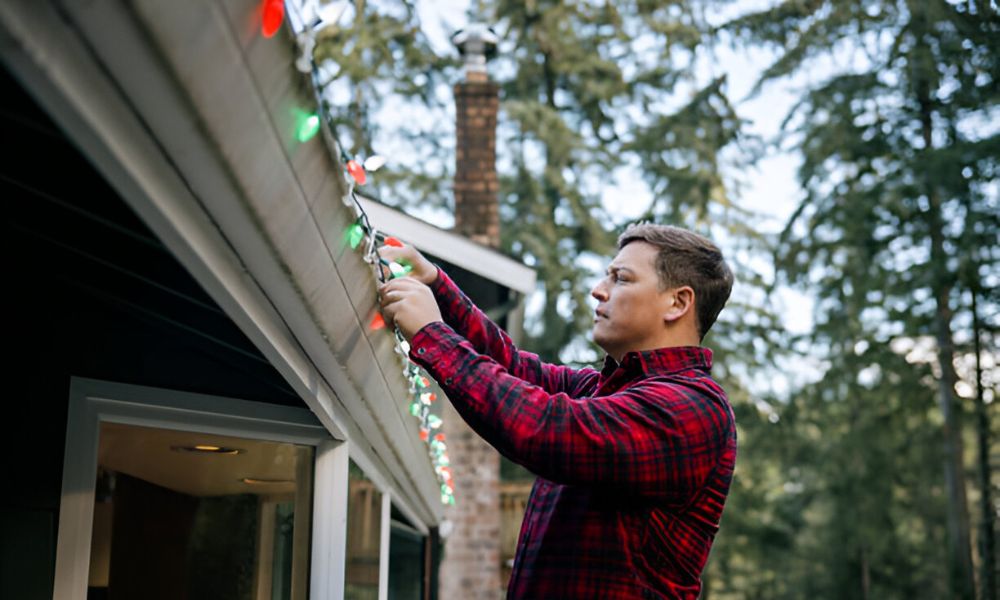Hanging lights for Christmas feels fun until you face stucco walls. Figuring out how to attach Christmas lights to stucco can be tricky. The rough texture makes tape slip, nails crack, and even glue fail. I still remember my first try—lights slid down, and I had a mess to fix.
Since then, I’ve learned easier ways. From Christmas light clips for stucco to safe tricks like testing hot glue on stucco, I’ve tried them all. I’ll also show you how to hang Christmas lights on a flat roof without stress.
This guide is simple, clear, and built on real tests at my own home. You’ll learn how to hang Christmas lights on stucco without damage, hassle, or wasted time. Let’s get those walls glowing!
Why Hanging Christmas Lights on Stucco Feels Tricky
Stucco is not smooth like wood or siding. It’s bumpy, rough, and full of little holes. This makes it hard for tape or glue to stick. Nails and screws may crack the wall. That’s why hanging lights on stucco takes more care.
Most people ask, “How do I hang Christmas lights on stucco without damage?” That’s a great question. The truth is—many common methods just don’t work. Tape falls off. Hooks slide. Glue may leave marks.
I’ve been there. My first try was a mess. I used tape, thinking it would hold. It didn’t. The lights drooped and fell. It was cold, dark, and frustrating. But after many tries, I found better ways.
Now I know what works. And in this guide, I’ll share those tips so your lights stay up and your walls stay safe.
Best Methods to Attach Christmas Lights to Stucco
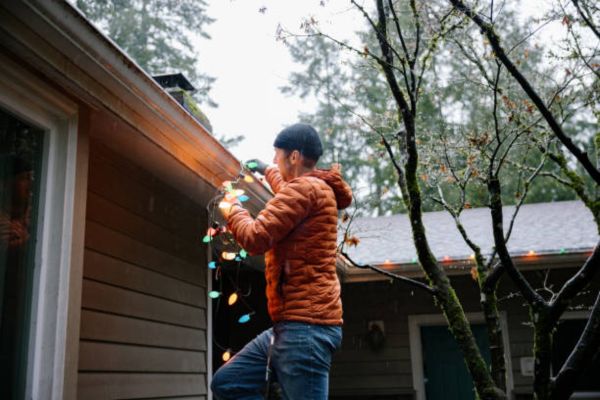
There’s no one-size-fits-all answer, but some tools make the job much easier. Below are the best ways to hang Christmas lights on stucco without damage.
Using Christmas Light Clips for Stucco (Safest Method)
If you want a clean, no-damage option, start with Christmas light clips for stucco. These clips are easy to find and safe to use. You can buy ones with sticky backs, gutter hooks, or all-in-one outdoor clips.
To hang lights with clips on stucco:
- Clean the spot with a dry cloth.
- Stick the clip on firmly.
- Let it sit for an hour if it’s adhesive-based.
- Gently press your lights into the clips.
These clips don’t hurt your wall. They’re easy to peel off and use again. Best part? No tools needed.
Hot Glue on Stucco – Does It Work?
Some people use hot glue for quick light hanging. Yes, it can work—but only if you’re careful.
Here’s the truth: hot glue holds well, but it may peel paint or leave marks. It’s great for short-term use, like a weekend party. But not so great for all-season setups.
I once used hot glue on a cold night. It worked for a few days, but later, the glue pulled some paint off. Lesson learned! Now I only use it on unpainted or hidden spots.
If you try this method:
- Use a low-temp glue gun.
- Do a test spot first.
- Don’t use it on painted stucco if you care about marks.
Pro tip: Always clean the area first. Glue sticks better to clean stucco.
Outdoor Adhesive Hooks
If you don’t want to drill or glue, outdoor adhesive hooks are a great middle ground. Brands like 3M Command make strong hooks for stucco and other rough walls.
To make them stick:
- Wipe the wall dry and clean.
- Press the hook firmly.
- Wait an hour before hanging lights.
Be careful in rain or snow. Moisture can weaken the grip. If your area gets frosty, check hooks often.
These are best for light strands and simple shapes. Not great for heavy garlands or bulky décor.
Drilling Hooks into Stucco (Permanent Option)
Want to keep hooks up year after year? Then drilling might be right for you.
Use this method only if you’re okay with leaving small holes. It’s best for heavy lights or big displays. Use a masonry bit and drill slowly to avoid cracks.
Safety tips:
- Don’t drill near corners.
- Avoid old or cracked stucco.
- Use wall anchors if needed.
You can also skip the stucco and drill into nearby wood trim or eaves. That’s what I do when I want to avoid patching holes later.
How to Hang Christmas Lights on a Flat Roof with Stucco Walls
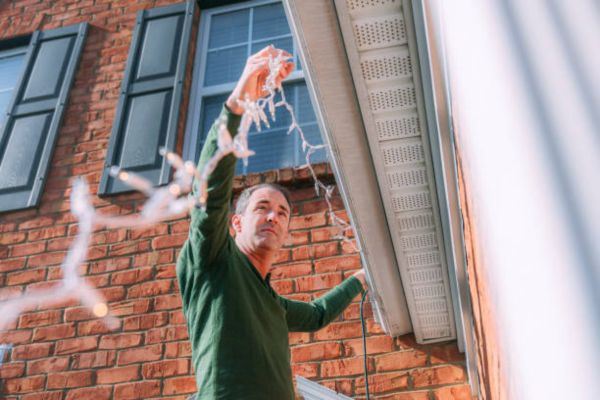
If you have a flat roof and stucco walls, don’t worry—you can still hang lights with ease. The trick is to focus on the roof edge, not the wall itself. Avoid attaching lights straight to stucco when you can. It’s faster, cleaner, and safer.
Three tools work great here:
- Gutter clips
- Shingle tabs
- Parapet hooks (great for flat, wide edges)
These let you hang lights without drilling or glue. Just clip them along the roofline. No contact with stucco means no cracks or marks.
Quick Tip: Always check that clips face outward and wires are tight. Loose wires flap in the wind and can damage your setup.
Step-by-Step Guide: My Process for Hanging Lights on Stucco

Over time, I’ve found a simple routine that works every time. If you’re not sure where to start, follow these easy steps. This is how I hang Christmas lights on stucco without stress or damage.
01. Plan the Layout and Measure the Area
I always start by sketching a rough layout. Decide where you want the lights to go—around windows, doors, or along the roof. Then measure the length so you know how many clips or hooks you’ll need.
Quick tip: Add a few extra feet for corners or bends. It’s better to have more lights than come up short.
02. Clean the Stucco Surface
Before sticking anything, wipe the wall with a dry cloth. Even a little dust can stop clips or glue from holding.
03. Choose the Right Hanging Method
Use Christmas light clips for stucco for most setups. If the wall is painted or rough, go with adhesive hooks. Only use hot glue if the surface is unpainted and you don’t mind some cleanup later.
I test different methods on small spots first. That way, I avoid surprises.
04. Attach Lights Carefully
Start in one corner and work your way across. Don’t pull the strand too tight. Leave a little slack, especially around corners.
Why it matters: Tight wires can pop clips loose or snap bulbs.
05. Step Back and Check Alignment
Once a few clips are up, I take a few steps back. This helps me spot if the line is crooked. Fixing it early saves time.
Fast tip: Use a second pair of eyes—or even your phone camera—to check alignment.
06. Secure Cords with Outdoor Extension Cords
Plug into an outdoor-safe power outlet. I use heavy-duty extension cords rated for winter use. Clip or tuck cords away from water and foot traffic.
Safety first: Never leave cords loose or near metal railings.
My Personal Tips for Success
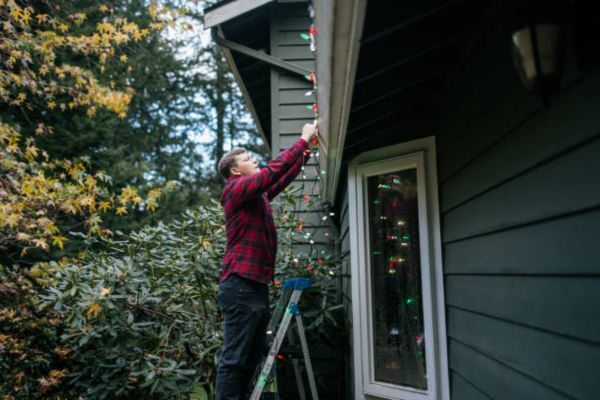
After years of trial and error, I’ve picked up a few tricks that make a big difference. These simple habits help keep my lights secure—and my stucco walls safe.
Test in a Hidden Spot First
Before using clips, glue, or hooks, I always test them in a small corner. It’s the best way to see what sticks—and what doesn’t—without messing up the front of your house.
Quick tip: A small test can save you hours of fixing later.
Use LED Lights
LEDs are lighter and don’t get hot. That means less pull on the clips and less risk of heat damage. Plus, they use less power and last longer.
Why it matters: LED lights are safer, cheaper to run, and better for outdoor use.
Don’t Overload Your Outlets
Stick with outdoor-rated power strips and surge protectors. Never plug too many strands into one outlet. I learned this the hard way one year—my breaker tripped, and half the lights went out.
Pro tip: Check the max wattage and stay under it. It keeps things safe and saves energy.
Take Them Down with Care
When the holidays end, don’t just yank the lights off the wall. I remove each clip or hook gently and store everything in labeled bins. That way, my stucco stays smooth—and I’m ready for next year.
Smart move: A careful takedown means no cracks, no chips, and no regrets.
Common Mistakes to Avoid When Hanging Lights on Stucco
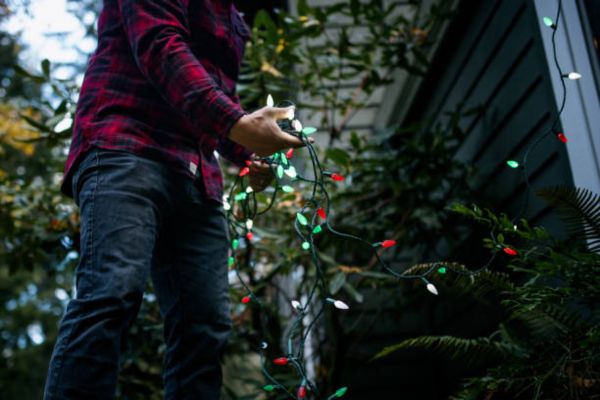
Hanging Christmas lights on stucco isn’t hard—but small mistakes can lead to big problems. Here are some things I learned the hard way (so you don’t have to):
Using Indoor Adhesives Outside
Not all sticky hooks are made for the cold or rain. If you use indoor tape or regular wall hooks, they’ll fall off fast.
Quick tip: Always check the label. Use outdoor-rated adhesive products only.
Applying Hot Glue Without Testing First
Hot glue might sound like a quick fix—but it can peel paint if you’re not careful. I once tried it without a test, and it pulled off a chunk of color.
Safe move: Test a small spot first, and only use low-temp glue on unpainted areas.
Drilling Too Close to Stucco Edges
Stucco can crack if you drill near corners or thin spots. The edges are more fragile than they look.
Drill smart: Stay at least 2–3 inches from any edge, and use a masonry bit.
Skipping Weatherproof Extension Cords
This one’s about safety. Regular cords aren’t made for snow, rain, or freezing temps. And if they get wet, you risk a short—or worse.
FAQs
What’s the best way to hang Christmas lights on stucco without drilling?
The best way is to use adhesive-backed Christmas light clips for stucco. They stick well without tools and won’t damage your wall. Just clean the surface first and press the clips firmly.
Will hot glue damage stucco walls?
It can. Hot glue holds tight but may peel paint or leave marks, especially on painted stucco. If you use it, test a small spot first and choose low-temp glue for safer results.
Can I use Command hooks on stucco?
Yes, but only outdoor-rated Command hooks. Make sure the stucco is clean and dry. Press the hook firmly and wait an hour before hanging lights.
Final Thoughts
Yes—you can hang Christmas lights on stucco without causing damage. You just need the right tools and a little care. Whether you use clips, hooks, or even glue, there’s a method that will work for your wall.
Now my holiday lights stay up all season long, and my stucco walls are still in perfect shape. I no longer stress about peeling paint or falling strands. And every year, setting up feels easier.

